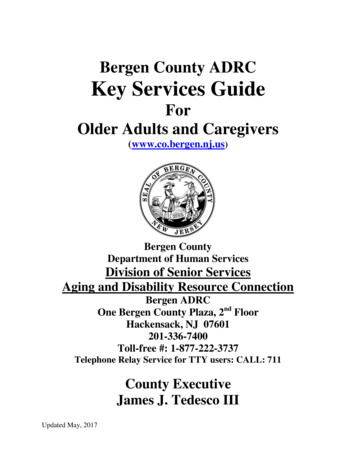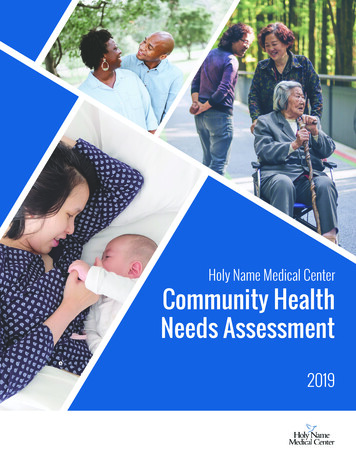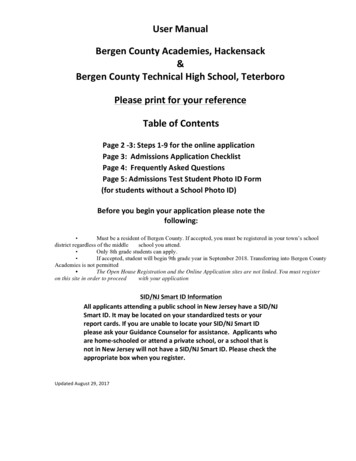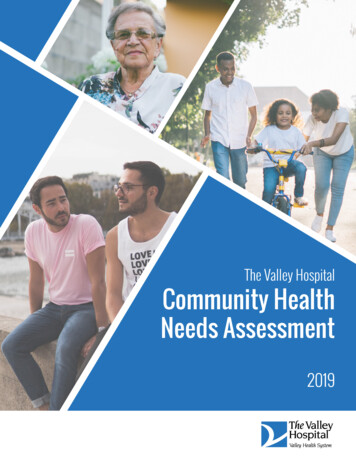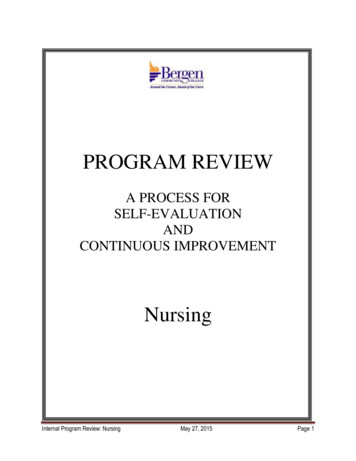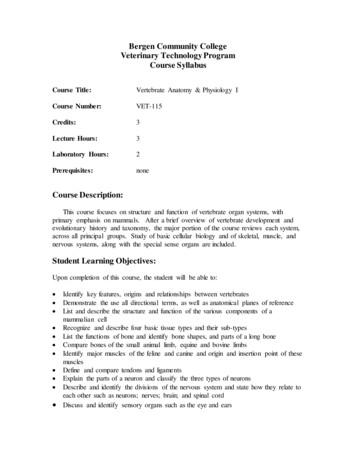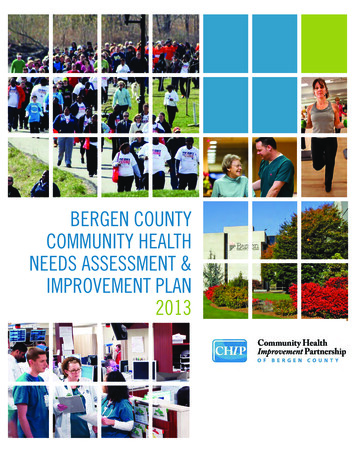
Transcription
BERGEN COUNTYCOMMUNITY HEALTHNEEDS ASSESSMENT &IMPROVEMENT PLAN2013
AcknowledgementsTHE BERGEN COUNTY COMMUNITY HEALTH NEEDS ASSESSMENT (CHNA) AND STRATEGICPLANNING PROJECT WAS MADE POSSIBLE THROUGH THE GENEROUS SUPPORT of ChristianHealth Care Center, Englewood Hospital and Medical Center, Hackensack University MedicalCenter, Holy Name Medical Center, and The Valley Hospital. Representatives from these fivehospitals, along with representatives of the Bergen County Department of Health Services(BCDHS) and the Community Health Improvement Partnership (CHIP) of Bergen Countyworked collaboratively for more than a year to conduct this assessment and planning project.A steering committee made up of senior representatives from each hospital and the CountyDepartment of Health Services guided this project. An advisory committee, which includedadditional staff from the participating hospitals and BCDHS, as well as representativesfrom local health departments and a number of Bergen County’s leading health and socialservice organizations, provided additional input. The combined expertise, knowledge, andcommitment of the members of these committees was vital to this project. Marla Klein,Partnership Coordinator at BCDHS and Coordinator of the CHIP, managed the project andwas the main liaison between the steering committee and John Snow, Inc., the consultingcompany that was hired to assist with the assessment. Ms. Klein deserves special recognitionfor her tireless oversight and support of the CHNA process.During this project, dozens of individuals were interviewed by John Snow, Inc. includingadministrative and clinical staff from the hospitals, representatives from health and socialservice agencies, public health officers, other public and elected officials, representativesfrom advocacy organizations and foundations, and community residents. John Snow, Inc.also conducted a random household mail survey with more than 1,700 residents fromBergen County. A pool of research assistants augmented these findings by collecting nearly400 additional surveys from low-income, racial/ethnic minority residents of the County atcommunity-based health and social service organizations, open-air markets, faith-basedorganizations, and other community venues. Finally, information was gathered by the JSIproject team from community residents, service providers, and other community healthstakeholders through a series of focus groups and listening sessions. These informationgathering efforts allowed the steering and advisory committees to gain a better understandingof the health status, health care needs, service gaps, and barriers to care of those living inBergen County. The Steering Committee would like to thank all of the people who wereinvolved in this project, particularly those who participated in interviews, survey efforts,focus groups, and community listening sessions.
Leadership Steering CommitteeCathy Pilone, Christian Health Care CenterMichael Pietrowicz, Englewood Hospital and Medical CenterTom Flynn, Hackensack University Medical CenterCatherine Yaxley, Holy Name Medical CenterColette Cummings, The Valley HospitalMarla Klein, Bergen County Department of Health ServicesElizabeth Rubock, Bergen County Department of Health ServicesAdvisory CommitteeNancy Mangieri, Bergen County Dept. of Health ServicesDoug Struyk, Christian Health Care CenterDave Volpe, Borough of BergenfieldNelson Xavier-Cruz, City of EnglewoodJohn Christ, City of HackensackNancy Ellson, Holy Name Medical CenterPaul Ostrow, Holy Name Medical CenterVinny Urgola, North Hudson Community Action CorporationSara Berk, The Valley HospitalGail Callandrillo, The Valley Hospital
Executive Summaryoverview, purpose, and collaborationBergen County’s hospitals, public health institutions, and leading health and social serviceagencies have a long history of collaboration that has helped to make Bergen County one ofthe healthiest counties in the State of New Jersey. In fact, in 2013, the Robert Wood JohnsonFoundation’s County Health Rankings and Roadmaps Program ranked Bergen Countyas the fourth-healthiest county of the state’s 21 counties1. This collaboration was initiatedin 1996 when the County’s hospitals, the Bergen County Department of Health Services(BCDHS), many of the leading health, social service, and academic organizations, andmembers of the community created a coalition to develop programs that would improvethe health of the community. In 2006, this partnership was formalized with the creation ofthe Community Health Improvement Partnership (CHIP).The CHIP’s mission is to promote collaboration across the County’s leading public andprivate community health stakeholders, ultimately to ensure that Bergen County’s residentshave access to resources that enable them to reach optimum health, well-being, and qualityof life. The CHIP has implemented numerous community health improvement projects,with the support of hospitals, local foundations, the county executive, and the communityand has conducted a series of needs assessment and planning projects that have guidedcommunity health improvement. The CHIP’s last community health needs assessment(CHNA) and community health improvement plan was completed in 2006. This report is aformal update of that assessment and planning process.This report is the culmination of nearly 18 months of work and was made possible throughthe generous support of the County’s five nonprofit hospitals; Christian Health CareCenter, Englewood Hospital and Medical Center, Hackensack University Medical Center,Holy Name Medical Center, and The Valley Hospital. The hospitals’ desire to conductthe assessment and update the 2006 Bergen County Community Health ImprovementPlan was borne largely of their commitment to the County’s residents and their wish tocontinue their support of the CHIP. However, the project also fulfills a new federal InternalRevenue Service (IRS) requirement, built into the new Patient Protection and AffordableCare Act (PPACA) (National Health Reform), which mandates that all nonprofit hospitalsconduct a CHNA and strategic planning process every three years. PPACA requires thatthe CHNA assess community health need, identify priority health issues and create acommunity health improvement strategy that addresses how the hospitals, in collaborationwith the community, will address the needs and the priorities identified by the CHNA.
BergEn County 2013 Community Health NeeDs AssessmentPPACA strongly encourages hospitals to conduct their CHNAs collaboratively across hospitalsand services areas. Bergen County’s nonprofit hospitals have clearly fulfilled this desire byworking together through the CHIP. In addition, Bergen County, through the CHIP andBCDHS, collaborated with two neighboring counties to share data and information. TheCHNA Steering Committee worked closely with Sister Marion Scranton at St. Mary’s Hospitalin Passaic County, New Jersey to share information and coordinate their efforts, and sharedinformation with the Rockland County Health Department, which provided their recentlycompleted CHNA report as a resource for this effort. Palisades Medical Center in HudsonCounty, New Jersey was also approached but opted to work independently.approach and processThe assessment and planning process was conducted in three phases, which allowed thecollaborating organizations to: 1) identify and clarify the health care needs and priorities ofthe residents of Bergen County; 2) engage stakeholders, including key service providers andresidents throughout the County; and 3) develop a detailed Bergen County Community HealthImprovement Plan. Each of the five partnering hospitals, in turn, is developing individualimplementation plans that will draw from the countywide plan. These individual plans willleverage the hospital’s strengths and resources and allow them to meet the needs of those wholive and work in the communities they serve.The assessment process compiled and analyzed an array of quantitative and qualitative healthrelated data through community interviews, household and community surveys, and focusgroups. For the purpose of this assessment, the steering committee defined health broadly toinclude not just health status and the existence of disease but also social factors, access to careissues, and overall determinants of health. Data was collected at County-level and wheneverpossible at the city, town, and borough level. State and national data was also compiled tofacilitate comparison and benchmarking of County and local data. Key findings from thesedata are summarized and the bulk of the data is provided in the appendices to this report.
BergEn County 2013 Community Health NeeDs Assessmentcommunity health priorities andtarget populationsOnce all of the assessment’s health-related data was compiled, the steering committeeimplemented a comprehensive strategic planning process involving the hospitals,public health agencies, the County’s leading health and social service providers, and thecommunity at-large. The first task in this process was a strategic planning retreat involvingthe members of the CHNA’s steering and advisory committees. Individual strategicplanning meetings were then convened with each of the participating hospitals, theBergen County Health Department, and CHIP. The project’s findings were also presentedto a number of community groups, including local health department officials, dischargeplanners and case managers from the participating hospitals, and the Bergen CountyMental Health Task Force. Finally, preliminary findings and results were presented tothe public at CHIP’s annual meeting, which nearly 100 community residents and othercommunity health stakeholders attended.The feedback and ideas collected during these meetings and community listening sessionsset the stage for the strategic planning process and helped the steering committee toidentify a series of County-wide community health priorities as well as demographic, socioeconomic, and geographic target populations. The following are the community healthpriorities and the target populations that the steering committee and the other public healthand community health stakeholders identified during this strategic planning process.OBESITY,FITNESS,NUTRITION, ANDCHRONIC DISEASEMENTALHEALTHANDSUBSTANCEABUSEACCESS ELDERTO CARE HEALTHOLDERADULTSLOWINCOMERACIALETHNICMINORITIES
BergEn County 2013 Community Health NeeDs Assessmentstrategic goals & core CommunityHealth strategiesThe ultimate purpose of this assessment was to provide actionable data and information alongwith a detailed strategic plan that would engage the community, promote collaboration, andguide the County’s community health improvement efforts. With this in mind, the steeringcommittee was charged with identifying a series of goals and objectives along with a setof evidenced-based strategies that would guide the implementation process and becomethe core of the County’s and CHIP’s community health improvement plan. The steeringcommittee agreed that whatever goals were identified needed to be attainable using existingresources. The strategies identified also needed to be shown in the existing peer-reviewedliterature to be effective and cost-efficient. Finally, the associated community healthimprovement plan needed to be aligned with existing national, state, and county strategiesbeing promoted by other private and public agencies, such as the New Jersey Department ofHealth’s Shaping NJ initiative, related to obesity, fitness, and nutrition.The following, organized by priority area, are the strategic goals that resulted from thesteering committee retreat, the individual hospital meetings, and the community listeningsessions.Priority Area One: Obesity, Fitness, Nutrition & Chronic DiseaseGoal 1: Increase physical activityGoal 2: Increase healthy eatingGoal 3: Increase the number of residents who maintain a healthy weightGoal 4: Promote care coordination and engagement in primary careGoal 5: Improve screening and identification of chronic disease and its risk factorsGoal 6: Promote chronic disease management and behavior changePriority Area Two: Mental Health and Substance AbuseGoal 1: Reduce depression and isolationGoal 2: Reduce anxiety and stressGoal 3: Reduce stigma related to mental illnessGoal 4: Reduce risky and binge drinkers (alcohol)Goal 5: Reduce prescription drug abusePriority Area Three: Access to CareGoal 1: Promote access to and engagement in primary careGoal 2: Promote access to and engagement in dental careGoal 3: Promote access to and engagement in behavioral health careGoal 4: Promote access to and engagement in medical specialty careGoal 5: Increase access to culturally and linguistically appropriate careGoal 6: Reduce transportation barriers
BergEn County 2013 Community Health NeeDs AssessmentPriority Area Four: Elder HealthGoal 1: Reduce inappropriate hospital readmissionsGoal 2: Reduce transportation barriersGoal 3: Increase access to caregiver support programsGoal 4: Increase access to end-of-life and palliative care programsAfter considerable discussion and review of the literature, the Steering Committee identifiedthe following set of core strategies and agreed that, in addition to their existing communityhealth improvement efforts, they would advocate for and promote the development ofprograms in these areas.expansion of ACCESS to servicesExpand capacity to behavioral health, dental, and medical speciality care services intargeted ways, particularly among the healthcare safety net that serves underserved, lowincome, and racial/ethnic minority populations who are more likely to be uninsured orunderinsured. Efforts should also reduce barriers to care such as transportation, language,culture, health literacy, and administrative barriers to maintaining insurance coverage.CHRONIC DISEASE MANAGEMENT PROGRAMSEnsure that individuals with or at particular risk of contracting chronic conditions haveaccess to evidenced-based programs that raise awareness, provide education on risk factorsand health promotion ideas, and include self-management supports that help individualsmanage their conditions and change risky or unhealthy behaviors.COMMUNITY-BASED HEALTH and WELLNESS promotionBuild on existing lectures, workshops, health fairs, screening events, and other programscurrently sponsored by hospitals, health departments, and other community healthpartners in Bergen County. Findings from the community health needs assessment shouldbe used to refine and focus these activities.DEVELOPMENT OF diabetes collaborativeThe diabetes collaborative would be a community coalition of health and social serviceproviders committed to working together to improve the health and wellbeing of Bergen
BergEn County 2013 Community Health NeeDs AssessmentCounty residents with diabetes or at-risk of contracting diabetes. Activities could includelinking people without a primary care provider to a medical home, increasing access to chronicdisease management and self-management support services, advocating for effective policyand practice change, sharing best practices, and promoting effective prevention strategies.PRIMARY CARE ENGAGEMENTLink people in need to appropriate services, address social determinants of health, promoteengagement in care, and improve care coordination and follow-up care. The programs shouldtarget specific at-risk populations by socio-economic status, race/ethnicity, geography,and health condition. Programs should provide general health education and ensure thatparticipants are engaged in primary care and other appropriate services. These activitiesshould be provided in conjunction with chronic disease management and behavior changeprograms.BEHAVIORAL HEALTH INTEGRATIONFacilitate targeted or universal screening for mental health conditions and substance abusein the primary care setting and ensure that people identified with mental health or substanceabuse issues are linked to and engaged in care either through formal, enhanced referralarrangements with other behavioral health providers, or through a co-located therapistoperating within the primary care clinic.PUBLIC HEALTH AND ENVIRONMENTAL INTERVENTIONSDevelop local laws and adopt formal policies by boards or commissions that protect publichealth, improve enforcement, or change practices in community settings such as in restaurants,grocery stores, and schools. The CHIP should work with state and local policy makers andcommunity leaders to advocate for these efforts.REDUCTION OF INAPPROPRIATE HOSPITAL UTILIZATIONBuild on existing hospital and community-based efforts and work to reduce the burden andcosts associated with inappropriate emergency department and hospital inpatient utilizationor inappropriate hospital readmissions. Manage high-utilizers in the emergency department,enhance discharge planning, improve care transitions, and enhance care management andcare coordination activities. Emergency department efforts should target “frequent flyers” aswell as those with mental health and substance abuse conditions. Inpatient programs shouldfocus on older adults with congestive heart failure, pneumonia, and COPD.
BergEn County 2013 Community Health NeeDs AssessmentWORKSITE HEALTH and WELLNESS promotionPromote informational and educational strategies, behavioral strategies, policy and environmentalapproaches, and comprehensive wellness strategies in worksite settings that address health issuessuch as smoking cessation, stress management, and cholesterol reduction.Expansion ofAccess toServicesWorksiteHealth andWellnessPromotionReduction nagementProgramsEmergingCoreStrategiesPublic HealthandEnvironmentalInterventionsCommunityHealth andWellnessPromotionDevelopmentof imary CareEngagement
BergEn County 2013 Community Health NeeDs AssessmentThe Community Health Improvement Partnership (CHIP) of Bergen County iscomprised of community residents as well as more than 50 health, public health, socialservice, housing, school, business, and other community organizations, including eachof the major non-profit hospitals in Bergen County. CHIP has been operating in BergenCounty since 2006 and over this time has played a critical role in facilitating communityhealth assessments, strategic planning, and health improvement. CHIP members workcollaboratively to implement and promote community health initiatives that improve thehealth and well-being of those who live, work, or attend school in Bergen County.CHIP VALUES Systems thinking Strategic thinking Dialogue Action Shared vision Celebration of successes Data-based assessment/evaluation partnershipsCHIP VISIONAll people in Bergen County will have access to resources that enable them to reach optimumhealth, well-being and quality of life, supported by a continually improving, clean, safe andeconomically sound community. Community stakeholders will collaborate to create andleverage resources to build a healthier Bergen County.
BergEn County 2013 Community Health NeeDs AssessmentTABLE OF Contentsbackground & approach.1Overview & purpose.1Assessment and planning Approach & Methods.2population characteristics & social determinants of health.7key findings by priority area.11Priority Area 1: Obesity, fitness, nutrition, and chronic disease.12obesity, fitness, nutrition.12cardiovascular health and diabetes.16cancer health.19respiratory health.21infectious disease.23Priority Area 2: mental health and substance abuse.25mental health.25substance abuse.28Priority Area 3: access to care.30insurance coverage.31access to care.32Barriers to access.34Priority Area 4: elder health.35chronic disease.36mental health and substance abuse.36access to care.37community health priorities and target populations.38summary community health improvement plan & core strategies.40priority area 1: obesity, fitness, nutrition, and chronic disease .40priority area 2: mental health and substance abuse.42priority area 3: access to care.44priority area 4: elder health.46core strategies.47
BergEn County 2013 Community Health NeeDs AssessmentTABLE OF FIGURES»» FIGURE 1: Summary of Approach and Methods»» FIGURE 2: Phase I: Methods»» FIGURE 3: Phase II: Methods»» Figure 4: Map of county with public health regions»» FIGURE 5: Race/Ethnicity & Age, Income, Education & Employment, and Quality of Life & Crime»» FIGURe 6: Community Health Priority Areas»» FIGURE 7: Overweight & Obesity»» FIGURE 8: Lack of Physical Activity»» figure 9:map of all cause hospitalization rates»» FIGURE 10: Diabetes Prevalence»» FIGURE 11: Hypertension Prevalence»» FIGURE 12: Cancer Screening Rates»» FIGURE 13: Asthma Prevalence»» FIGURE 14: Smoking Prevalence»» FIGURE 15: Sexually-Transmitted Disease Rates»» FIGURE 16: Depression and Anxiety Prevalence»» FIGURE 17: Mental Health/Substance Abuse Inpatient Hospitalization Rates»» FIGURE 18: excessive, heavy, and Binge Drinking Prevalence»» FIGURE 19: Medical and Dental Insurance Rates»» FIGURE 20: access to prescription medications»» FIGURE 21: Routine Medical/Dental Check-Up Rates»» FIGURE 22: Emergent and Non-Emergent ED Utilization»» FIGURE 23: Chronic Disease Prevalence - Physical Health by Age»» FIGURE 24: Chronic Disease Prevalence - Behavioral Health by Age»» FIGURE 25: Community Health Priorities»» FIGURE 26: Target Populations»» FIGURE 27-30: Summary Strategic Plan by Priority Area
BergEn County 2013 Community Health NeeDs AssessmentBackground & ApproachOVERVIEW & PURPOsEIn 2006, the Community Health Improvement Partnership (CHIP) completed a communityhealth assessment for Bergen County and developed an associated community healthimprovement plan. As a result of this assessment the CHIP created five task forces: 1)Access to Health Care; 2) Mental Health; 3) Nutrition and Physical Activity; 4) Alcohol,Tobacco and Other Drugs; and 5) Communication of Health Issues. These task forcesworked with CHIP members and other stakeholders on numerous initiatives related toeducation, prevention, and advocacy geared to improving the health of the region. In2012, with the generous support of Christian Health Care Center, Englewood Hospital andMedical Center, Hackensack University Medical Center, Holy Name Medical Center, andThe Valley Hospital, the CHIP made a commitment to update the 2006 Bergen CountyCommunity Health Improvement Plan and contracted with John Snow, Inc., (JSI) anationally recognized public health research and consulting firm, to assist them with theassessment and planning process.The hospitals’ desire to conduct the assessment and update the 2006 Bergen CountyCommunity Health Improvement Plan was borne largely from their commitment to theCounty’s residents and their wish to continue their support of the CHIP. In addition, theproject fulfills a new federal Internal Revenue Service (IRS) requirement, built into the newPatient Protection and Affordable Care Act (PPACA) (National Health Reform), whichmandates that all nonprofit hospitals conduct a community health needs assessment andstrategic planning process every three years. The requirement further stipulates that thecommunity health assessment must involve local public health officials, other health andsocial service providers, and community residents. Finally, the requirement mandates thedevelopment of an associated strategic plan to guide the area’s healthcare, public health, andsocial service organizations and the community in their efforts to address the assessments’priorities.PAGE 1
BergEn County 2013 Community Health NeeDs AssessmentIn addition, the Public Health Practice Standards for Local Boards of Health in NewJersey and the national Public Health Accreditation Board require that the Bergen CountyDepartment of Health Services (BCDHS) and the County’s local health departments completea community health needs assessment and implement a related health improvement plan.With these commitments and public mandates in mind, the hospitals, BCDHS, and theCHIP came together to conduct a three-phased community health needs assessment andplanning project, and to update the CHIP’s existing community health improvement plan.The Mobilizing for Action through Planning and Partnerships (MAPP) process helpedinform the planning processes.2 MAPP is a community-driven strategic planning processfor improving community health. The MAPP process utilizes four types of communityhealth needs assessments: 1) a community themes and strengths assessment; 2) a local publichealth system assessment; 3) a community health status report; and 4) a forces of changeassessment. While this present effort did not utilize the MAPP process specifically, all fourof the MAPP assessments were addressed in the various components of the approach thatwas applied for this assessment and planning project.ASSESSMENT AND PLANNING APPROACHAND METHODSA steering committee made up of senior representatives from each hospital and the CountyDepartment of Health Services guided this project. An advisory committee, which includedadditional staff from the participating hospitals and BCDHS, as well as representativesfrom local health departments and a number of Bergen County’s leading health and socialservice organizations, provided additional input. The assessment and planning process wasimplemented by the steering committee and was conducted in three phases, which helpedthe steering committee to: 1) identify and clarify the healthcare needs and priorities ofthe residents of Bergen County; 2) engage stakeholders, including residents throughoutthe service area; and 3) develop a detailed, action-oriented strategic plan. The assessmentcollected an array of quantitative and qualitative data that contributed to a strategicplanning process and led to the development of the 2013 Bergen County CommunityHealth Improvement Plan. A summary of the plan is included in this report.PAGE 2
BergEn County 2013 Community Health NeeDs AssessmentFigure 1: Summary of Approach and MethodsPhase I: Preliminary Assessment & Community EngagementSecondary Data CollectionCommunity InterviewsPhase I Steering CommitteeMeetingPhase II: Targeted Assessment &Community EngagementPhase III: StrategicRandom HouseholdPlanning & ReportingSurveyCommunity SurveyFocus GroupsPhase II SteeringCommittee MeetingStrategic Planning RetreatCommunity Listening SessionHospital and CHIP IndividualPlanning MeetingsCHIPS Annual MeetingFinal ReportingIn Phase I, the preliminary needs assessment and community engagement effort reliedheavily on information collected through existing secondary data from local, state, andnational sources. These sources included data on the characteristics of the Bergen Countypopulation, as well as their social determinants of health, current health status, access tocare, health-related risk factors, and overall morbidity and mortality. Dozens of interviewswere also conducted in Phase I to start the community engagement process and capturecommunity perceptions on priority health issues, service gaps, barriers to access
Center, Englewood Hospital and Medical Center, Hackensack University Medical Center, Holy Name Medical Center, and The Valley Hospital. The hospitals' desire to conduct the assessment and update the 2006 Bergen County Community Health Improvement Plan was borne largely of their commitment to the County's residents and their wish to
